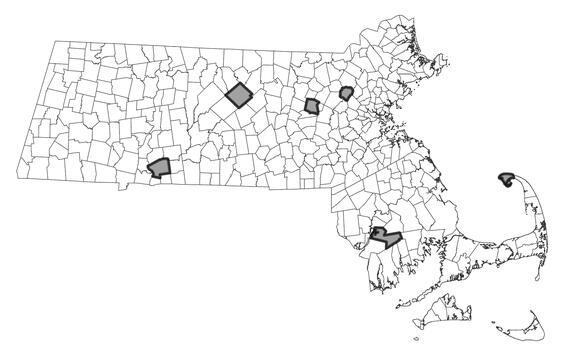- Scientific name: Carex oligosperma
- Species of Greatest Conservation Need (MA State Wildlife Action Plan)
- Endangered (MA Endangered Species Act)
Description
The few-seeded sedge belongs to a section of the genus Carex called the Vesicariae. Members of this section are characterized by three stigmas per flower (and subsequently three-sided achenes) and inflated perigynia, usually terminated by a two-toothed beak. Indeed, the perigynia of the few-seeded sedge do appear inflated, resembling small bladders with a slender beak at the apex. The beak is terminated by two tiny teeth that require magnification to see. As its name implies, the few-seeded sedge has relatively few carpellate flowers per spike (3–15) compared to closely related species. The leaves of this sedge are very narrow, only 1–3 mm (0.04-0.12 in) wide, wiry, and are curled in at the edges (involute).
There are several species in Massachusetts that resemble the few-seeded sedge. Two common and closely-related species that occur in wetlands include the sallow sedge (Carex lurida) and the inflated sedge (Carex vesicaria). Both have flat leaves that are usually wider than 3 mm (0.12 in), and they commonly have more cylindrical spikes than few-seeded sedge owing to the greater number of perigynia per spike. The Endangered Michaux’s sedge (Carex michauxiana), which also can be found in acidic peatlands, superficially resembles the few-seeded sedge, but can be distinguished by its flat or M-shaped leaves and essentially uninflated, beakless perigynia.
Life cycle and behavior

Few-seeded sedge is a grass-like, perennial herb of acidic peatlands that spreads via underground stems called rhizomes. Growing as tall as 1 m (~3 ft), its stems are solitary or shortly spaced apart, sometimes forming large colonies. Few-seeded sedge has tiny, wind-pollinated flowers that are borne in compact spikes at the summit of the stem. Each flower is unisexual and closely subtended by a small, flat scale that largely conceals it. The staminate (i.e., pollen-bearing) flowers are subtended by a single scale. The carpellate (i.e., ovule-bearing) flowers are subtended by two scales, an outer flat scale and an inner, sac-like scale, called a perigynium, that encloses the flower. In the few-seeded sedge, the uppermost spike bears only staminate flowers, while the one to three lower spikes bear only carpellate flowers.
Population status
Few-seeded sedge is listed under the Massachusetts Endangered Species Act as Endangered. All listed species are protected from killing, collecting, possessing, or sale and from activities that would destroy habitat and thus directly or indirectly cause mortality or disrupt critical behaviors. This sedge is rare in Massachusetts because it is a cool-climate plant nearing the southern extent of its range; it is more abundant in the northern New England states. This sedge was once known from Connecticut but is now believed to be historic or extirpated there. The MassWildlife’s Natural Heritage & Endangered Species Program database has 14 records from 6 counties: Barnstable, Bristol, Essex, Hampden, Middlesex, Norfolk, and Worcester. 8 of these records have been observed within the last 25 years.
Distribution and abundance
Few-seeded sedge occurs from Newfoundland west to Alberta and south to North Carolina.

Distribution in Massachusetts
1999-2024
Based on records in the Natural Heritage Database
Habitat
In Massachusetts, the few-seeded sedge occurs in both basin wetlands, such as bogs, and river/lake-side wetlands. Associated species include rhodora (Rhododendron canadense), three-way sedge (Dulichium arundinaceum), leatherleaf (Chamaedaphne calyculata), silvery sedge (Carex canescens), wool-grass (Scirpus cyperinus), swamp candles (Lysimachia terrestris), large cranberry (Vaccinium macrocarpon), and Virginia chain fern (Woodwardia virginica).
Healthy habitats are vital for supporting native wildlife and plants. Explore habitats and learn about conservation and restoration in Massachusetts.
Threats
Threats to the few-seeded sedge are those that threaten the integrity of the natural communities it inhabits. These include changes in hydrology of the wetland (e.g., ditching, channelization, road construction) and invasive plant species such as common reed (Phragmites australis) and purple loosestrife (Lythrum salicaria). These two species are capable of replacing native vegetation in wetlands due to abundant seed production and vigorous vegetative growth.
Conservation
Recognition and control of invasive species will be important for maintaining relatively pristine habitats for rare plant species.
Contact
| Date published: | April 9, 2025 |
|---|